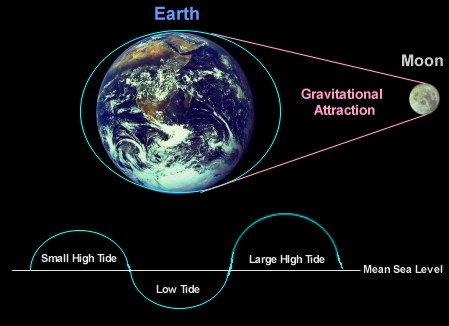
Much of the summer has been spent trying to work out a feasible way to capture the immense power of the tides here on the Little River in East Boothbay, Maine. They rise and fall twice a day around 12 feet. The kinetic force is huge and it lifts and lowers my 3-ton boat twice a day. There’s got to be a way to use it to power some of the things I currently pay Central Maine Power for. Then there’s the whole issue of living in a heated house while paying for electricity to keep a refrigerator inside it cold. Especially when there is infinite water 20 feet away at a temperature between 32 and 50 Fahrenheit depending on the season.
Anyway, the tidal thing is simple and complicated. I think I’ve solved a few of the troubles, but storage and use of DC current is still problematic. At the Common Ground Fair in Unity, Maine the other weekend, I talked with some proponents of hydrogen, created primarily by solar power (photovoltaic) as a stored energy and source for heating, or using (currently too expensive) fuel cells for electricity. God knows the state of the art in batteries still sucks, so storage is a key element here.
The basic idea involves a vertical column, rising from a small boat, probably a dinghy, and attached to the dock here so that the column, probably PVC pipe, can rise and fall with the tide. The column would either be lifting a weight that would fall at the tide change and either through cable and pulleys or a rack and gear system running the length of the column which would, at the point of greatest potential energy, turn it to kinetic energy driving a simple generator to charge a battery, create (and store) hydrogen or sell back to the electric utility.
All of the tidal programs I’ve seen to date use the current as the tides ebb and flow to run turbines. This creates a mess in turns of regulatory gridlock, and the requirement of massive scale. By using a dinghy as the only thing touching the water, it’s hard to see how any regulation could be required for something that only touches the ocean as a boat rising and falling with the tide. This just might drive the EPA nuts, but I think I’m on safe legal ground here.
So obviously there is a lot of power expended in raising our little boat 12 feet with a force of the boats rated load capacity of, let’s say 1000 pounds.
From www.howstuffworks.com we get this handy chart:
In (James) Watt's judgment, one horse can do 33,000 foot-pounds of work every minute. A horse exerting 1 horsepower can raise 330 pounds 100 feet in a minute, or 33 pounds 1,000 feet in one minute, or 1,000 pounds 33 feet in one minute. You can make up whatever combination of feet and pounds you like. As long as the product is 33,000 foot-pounds in one minute, you have a horsepower.
Horsepower can be converted into other units as well. For example:
0. 1 horsepower is equivalent to 746 watts. So if you took a 1-horsepower horse and put it on a treadmill, it could operate a generator producing a continuous 746 watts.
If I get my math right, our 1000-pound lift going 12 feet in 6 hours could generate 0.001 of horsepower (at perfect efficiency). If I have any readership, feel free to check my math. That works out to about 0.7 watts, which is the power generated by a really small solar panel. We can scale up the foot/pounds by upping the pounds, as the tide can lift a theoretical infinite weight.
Using my bigger boat, we can assume just over 3 tons of lift and generate just about 0.006 HP or 4.5 watts. I think I’ve found the flaw in my theory. A freaking 25,000-ton freighter rising and falling twice a day would generate 50 horsepower, about the same as a motorcycle. Perhaps I’m out of my mind, or perhaps I got the math wrong, but I swear there’s a pony somewhere under all this shit, I just need to keep digging.
Anyway, I hope I got the math wrong and there’s some potential to this, but right now I feel like an idiot. Maybe the refrigerator booster idea will work out better.


5 comments:
Tides have huge power, but spread far and wide. Waves on the other hand ... here's an interesting concept.
Scotland Plans World’s First Tidal Turbine Farms
here
art, I can't connect with your link.
This is very much an interesting topic, and problem.
I was actually thinking about this the other day. You know the fresh water swimming pool just up the road, and its little inlet? That seems to almost always have water rushing through it. That also has to translate into something.
???
Storage.
I'll keep reading.
and this is aaron signed on as carla.
It's frustrating to think all that power cannot be harnessed, but you are looking at the least mobile dimension...it takes maybe billions of gallons to flow into your little inlet to raise or lower that boat 12 feet, but another way to intuit it, and feel as well as know that your math is right is to think of the speed your boat/float rises and falls...2 feet an hour or .0004 MPH.
Assume at the least that the fresh water pool is maybe 300 meters by 100 meters and rises and falls 1 meter every 6 hours. that's 30,000 cubic meters or 5,000 per hour flowing through the opening that looks like maybe 1 meter by 1/4 meter...meaning a concentrated point of a lot of power. That's 30,000 metric tons eventually moving moving at an average speed of 25 MPH..but even then it can't turn a turbine or water wheel very forcefully because at any given time, the pressure is negligible.
But if you put an apparatus comparable to a wind turbine on the bottom of the inlet, all that volume and motion could be converted in a low torque mechanism to consistent energy ...That sounds like maybe what art is trying to show us.
Once you introduce moving blades in the water, you are in regulatory hell. The low impact use of a boat as the only thing touching the water was intended to be a get out of jail free card.
Post a Comment